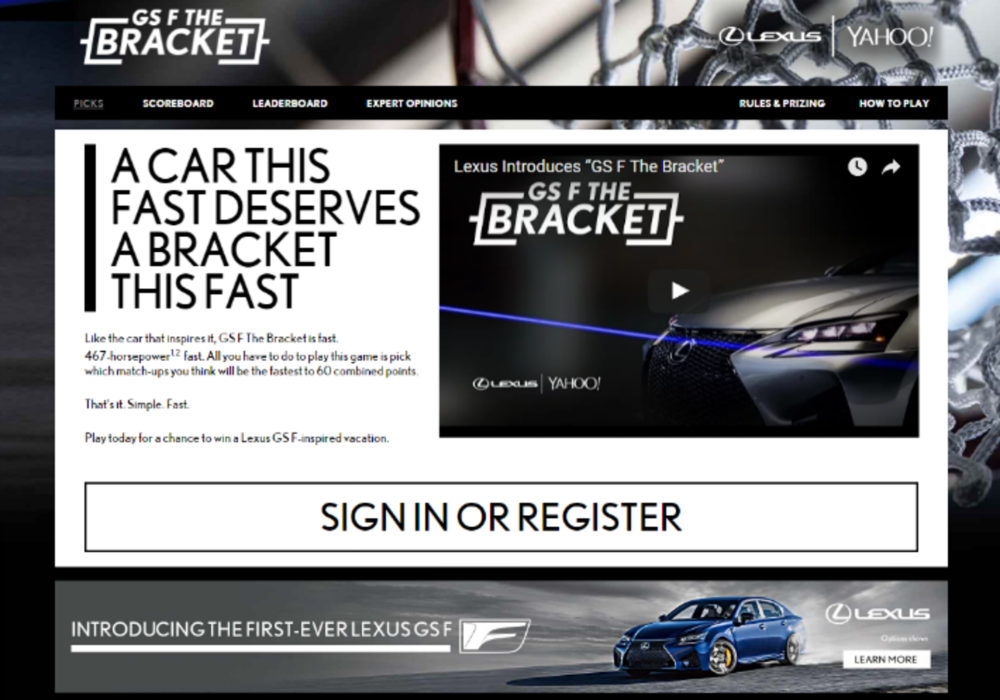Like basketball, programmatic advertising needs to be a team effort. Brad Piggott, VP and industry lead for Yahoo’s automotive vertical, says marketers need to double-team content and technology to produce immersive experiences that are part of an overall strategy, rather than a standalone entity.
Piggott and his team helped Lexus do just that when the two companies launched a custom branded game for the luxury automaker’s new 2016 Lexus GS F sedan during March Madness.
Jumping at the opportunity
Lexus’s Media Manager MaryJane Kroll wanted to find a way to promote the power and agility of the GS F while also tapping into the excitement around the 2016 NCAA Men’s Basketball Tournament. So, the company served as a presenting sponsor of Yahoo Sports’s Tourney Pick’em bracket and developed a custom game of its own: “GS F The Bracket.”
Unlike a traditional bracket where participants strive to pick the winning team, GS F The Bracket asked fans to pick which games would reach a combined 60-point total the fastest—a nod to the GS F’s ability to go zero to 60 in 4.5 seconds.
“Given that the GS F is the most powerful Lexus sedan yet, the vehicle appeals to luxury consumers who want the next level of performance on the road,” Kroll says. “They’re competitive and confident, and a fast-moving game like GS F The Bracket tapped into their desire to win.”
To participate in GS F The Bracket, fans had to visit the campaign’s website and create an account by registering their email address, entry name, and a password. Participants could also opt to receive email notifications when new picks were available. Once they were registered, players would predict which match-ups in a particular round would score a combined 60-points the fastest. When players made two or more accurate predictions, they were considered to be on a “winning streak” and would receive one point. Participants could win up to six points for a perfect set of predictions. But if a player made an inaccurate prediction or didn’t make a prediction at all, their winning streak would end and their streak count would reset to zero. During the final stage of the tournament, participants had to make two additional “tie breaker” predictions: How much time will elapse on the official game clock before the combined 60 points is reached and before an individual team scores 60 points? The participant with the highest point total wins and has the chance to go on a luxury vacation.
In addition to hosting GS F The Bracket game, the campaign website featured scoreboards, leaderboards, and expert-opinion videos.
Bouncing between touchpoints
To encourage participation, the companies prompted any fan who completed a Yahoo Sports bracket to sign up for the Lexus bracket, Kroll says. Lexus also promoted the campaign via paid placements on Yahoo (e.g. native, display, and video ads), its social media channels, and an integration with Yahoo Sports’s “Tourney Bracket Live” show.
“We wanted to reach people where they may have been reading about basketball or we wanted to reach them where they may have been reading about the new hottest cars,” Yahoo’s Piggott says. “So, we created an immersive ad experience to both inform [consumers] about the Lexus vehicle but then also drive to [the Lexus] promotion.”
Piggott also says that Lexus leveraged Yahoo’s DSP and combination of first- and third-party data to target consumers with these ads. For instance, he says that the companies could target consumers based on behavioral data, demographic information, and intent—such as whether people had been searching for “bracket challenges.”
Heating up
The campaign ran from March 13 to April 4, 2016. During this time, Lexus generated 165 million total impressions, 23 million total views, and 1.3 million page views for GS F The Bracket. The company also experienced a 15% lift in brand favorability and a 29% lift in purchase consideration—both measured through a Millward Brown study. The latter two figures were even higher among men (22% and 37%, respectively).
Despite this success, Kroll says she would have done a few things differently—mainly create more points of entry.
“The results of the custom campaign were powerful among all viewers,” she says. “If we were to do this again, we would have more points of entry to drive users back to the game and increase our integration into partner-owned content.”
So although the campaign wasn’t a complete slam dunk, it’s nice for Kroll to know that Lexus’s partners were there for the assist.
“This was the first time Lexus created a game around a major sporting event,” she says. “Working closely with our partners was key to conducting extensive testing, making real-time changes, and making sure we created a game that entertained fans, kept them coming back for more, and still delivered our vehicle messaging in an authentic way.”





